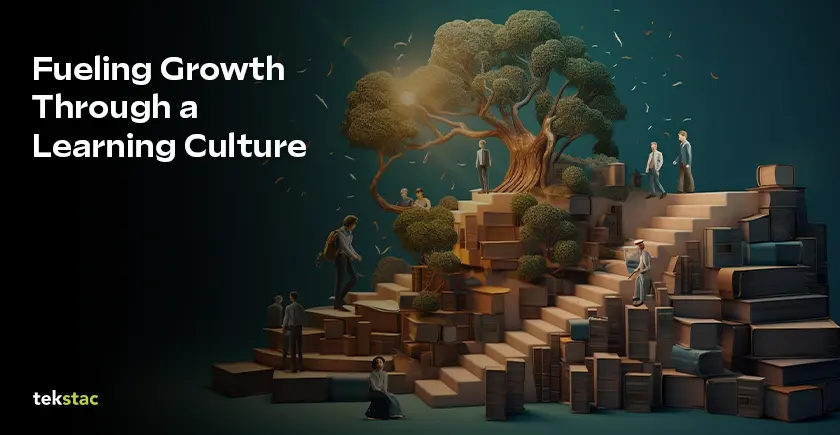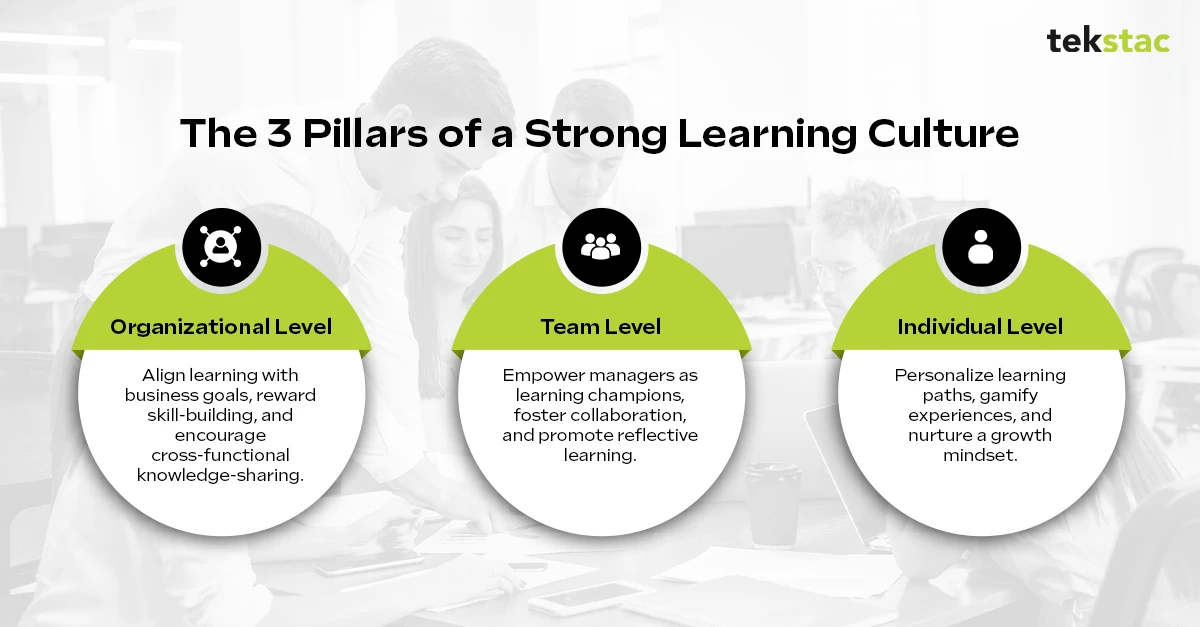AI-Powered Learning Culture Strategies to Inspire Continuous Growth

What makes employees stay, grow, and contribute their best? It’s not just a paycheck or job security, it’s the opportunity to learn and evolve. A strong, AI-powered learning culture gives people the tools to upskill, adapt, and drive business success through continuous, data-driven development.
The LinkedIn Workplace Learning Report 2025 reveals that companies investing in personalized, AI-powered L&D see higher engagement and retention. Employees now seek personalized workplace learning experiences that blend seamlessly into daily workflows rather than isolated training sessions. When organizations build a learning culture into their DNA, they don’t just build a skilled workforce, they build a future-ready business.
What Is a Learning Culture and Why Does It Matter?
A learning culture is not just about conducting training sessions; it’s about embedding learning into everyday work processes. A learning culture involves:
- Supporting individual learning and applying knowledge in real business scenarios
- Encouraging team learning and collective problem-solving
- Promoting knowledge sharing and continuous improvement at the organizational level
A strong, continuous learning culture powered by AI ensures employees are empowered to develop critical skills, innovate faster, and adapt to constant change. But the challenge lies in how to embed this culture into the organization’s DNA through effective workplace learning strategies.
What Are the Common Barriers to Building a Learning Culture (and How to Overcome Them)?
Many organizations struggle to establish a learning culture due to several key barriers, especially when training and development is not integrated with day-to-day work.
1. Lack of Leadership Support
76% of L&D professionals report that management does not prioritize learning. Leaders must set the tone by actively participating in and advocating for employee development.
2. Rigid Organizational Structures
Formal hierarchies and bureaucracies can make learning difficult. Employees may feel that learning takes them away from their core responsibilities. To counter this, organizations should embed adaptive learning for workforce upskilling directly into daily workflows, supported by intelligent learning platforms.
3. Inconsistent Learning Approaches
Some companies focus solely on formal training while neglecting informal, social, and digital learning. A mix of learning methods, such as mentorship programs, peer learning, and digital learning platforms—can enhance engagement.
4. Fear of Failure
Employees are often hesitant to experiment and take risks in learning due to fear of negative consequences. Encouraging a growth mindset and normalizing failure as a part of the learning process is essential.
3 Proven Strategies to Build a Strong Learning Culture
To develop a successful learning culture, organizations must take a systemic approach, integrating learning at three levels:

1. Organizational-Level Strategies
- Define and Communicate a Vision for Learning
- Leadership should clearly articulate how continuous learning aligns with business goals.
- For example, Google’s “20% time” policy allows employees to dedicate part of their workweek to learning and innovation.
- Develop Knowledge Management Systems
- Use AI-powered platforms to capture and share employee expertise.
- Encourage internal wikis, discussion forums, and collaboration tools for knowledge sharing.
- Build Learning into Performance Metrics
- Reward employees for mentorship, skill-building, and knowledge-sharing contributions.
- Link learning initiatives to promotion and performance reviews.
- Encourage Cross-Functional Learning
- Rotational programs and job shadowing opportunities can help employees gain a broader understanding of different business areas.
2. Team-Level Strategies
- Empower Managers as Learning Champions
- Equip managers with L&D training so they can support their teams effectively.
- Encourage managers to lead by example, demonstrating continuous learning in their own work.
- Foster Collaborative Learning
- Encourage team-based learning activities, such as hackathons, brainstorming sessions, and cross-team knowledge-sharing.
- Recognize and reward teams that innovate and solve problems collectively.
- Encourage Reflective Learning
- Implement “learning debriefs” after major projects to discuss what worked, what didn’t, and key takeaways.
- Introduce peer coaching and regular feedback sessions.
3. Individual-Level Strategies
- Personalized Learning Paths
- Offer customized learning plans based on individual career goals and skill gaps.
- Provide access to self-paced online courses, podcasts, and bite-sized learning modules.
- Leverage Gamification and AI
- Gamify learning by introducing leaderboards, challenges, and rewards.
- Use AI-powered tools to recommend relevant courses based on employees’ learning history and career progression.
- Promote a Growth Mindset
- Foster a culture of psychological safety where employees feel comfortable asking questions, experimenting, and making mistakes.
- Celebrate learning milestones and small wins.
Why AI-Powered Personalized Learning Drives Real Impact
Not all learning is equal. Your brain naturally pays more attention when something feels relevant and rewarding. That’s why personalized learning isn’t just a trend, it’s the key to making training actually work. A strong learning culture ensures employees are continuously engaged, motivated, and developing skills that matter.
Companies that get this right don’t rely on outdated, one-size-fits-all training. They use AI and VR to make learning interactive and tailored to each person.
- Your brain is wired for relevance – When learning connects to real goals, retention and engagement soar.
- Learning by Doing Beats Passive Training – Interactive experiences, real-world problem-solving, and hands-on practice help people absorb knowledge faster and apply it with confidence.
- Continuous Learning Keeps People Invested – When learning is a natural part of work, not just another training session, employees stay engaged and committed to their growth.
Companies with a strong learning culture experience 30–50% higher retention rates. Employees are more likely to stay in organizations that invest in their growth.
According to a study by Emerald Works, businesses with a mature learning culture see:
- 10% greater revenue growth
- 12% higher innovation rates
Future Trends in L&D: AI, VR, and Continuous Learning
1. AI & Machine Learning in L&D
- Adaptive learning platforms will personalize training content.
- AI-driven analytics will measure learning effectiveness.
2. Virtual Reality (VR) & Augmented Reality (AR)
- Companies will use VR simulations for real-world skill application.
- AR-enhanced onboarding programs will provide immersive learning experiences.
3. Microlearning & Just-in-Time Learning
- Employees prefer short, engaging learning modules that fit into their busy schedules.
- Mobile-based microlearning will become the norm.
4. Focus on Soft Skills Development
- With automation taking over routine tasks, emotional intelligence, adaptability, and critical thinking will be crucial skills in the future workplace.
Building a Strong Learning Culture with AI: The Tekstac Approach
A learning culture is not built overnight—it requires a strategic, long-term commitment from leaders, teams, and individuals. By embedding learning into everyday work, providing multiple learning opportunities, and aligning L&D with business objectives, organizations can unlock the full potential of their workforce.
Investing in learning today means building a workforce that is engaged, skilled, and ready for the future—especially when guided by the latest Learning and Development Trends shaping talent strategies globally. With Tekstac, learning isn’t just another checkbox—it becomes a part of everyday growth. Give your employees the tools to succeed, innovate, and thrive.
Transform the way your employees learn and grow with Tekstac Our cutting-edge platform offers AI-powered personalized learning, hands-on practice labs, and gamified learning to drive engagement and skill development.
Experience the Future of Learning & Development Today!
FAQs on Learning Culture
1. What are the 6 steps to creating a culture of learning?
Define a learning vision, enable leadership support, integrate AI tools, encourage collaboration, personalize learning paths, and reward continuous skill growth organization-wide.
2. How can AI help build a learning culture?
AI personalizes learning paths, recommends relevant content, tracks progress, and enables adaptive, continuous upskilling aligned with business goals and employee performance.
3. Why is a learning culture important for retention?
Employees stay longer when learning is continuous, personalized, and rewarding—it boosts engagement, growth opportunities, and trust in organizational development.
4. How can Tekstac help build a learning culture?
Tekstac uses AI-powered personalization, gamified learning, and hands-on labs to embed continuous learning into workflows, improving engagement, skills, and retention.





